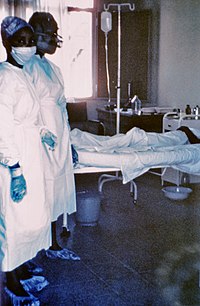
Photo from wikipedia
Ebola virus (EBOV) outbreaks can claim numerous lives and also devastate the local health infrastructure, as well as the economy, of affected countries. Lethal EBOV infection has been documented to… Click to show full abstract
Ebola virus (EBOV) outbreaks can claim numerous lives and also devastate the local health infrastructure, as well as the economy, of affected countries. Lethal EBOV infection has been documented to decrease the levels of several immune cells in the blood that are necessary to defend the host. This decrease in immune cells is, however, not observed in individuals who survive EBOV infection. Having a better grasp of how these immune cells are lost is therefore of high importance to develop and improve new and existing therapeutics. The significance of our research is in identifying the mechanism responsible for the apparent loss of immune cells in lethal EBOV infection. This will allow therapeutic options aimed at preventing the loss of these immune cells, therefore allowing infected individuals to better fight the infection. ABSTRACT Understanding the immune parameters responsible for survival following Ebola virus (EBOV) infection is paramount for developing countermeasures. In lethal EBOV infections, levels of both NK and T cells decline drastically in the circulation and lymphoid tissues before death. However, the fate of these lymphocytes in viral replication sites remains unknown. In this study, reverse transcription-PCR (RT-PCR) and fluorescence-activated cell sorting (FACS) analysis were used to investigate lymphocyte frequencies in various infected mouse tissues after challenge with mouse-adapted EBOV (MA-EBOV). A decrease in NK cell numbers from systemic circulation was observed concomitant to an increase of these cells in tissues that are supporting active replication of EBOV. Unexpectedly, NK accumulation in virus replication sites correlated with enhanced EBOV disease progression in specific conditions; at a high challenge dose, NK-depleted mice displayed lower viremia and liver damage and higher hepatic T cell levels. Upregulation of UL16 binding protein 1 (ULBP-1) was detected in hepatic T cells, suggesting that NK cells participate in their elimination. Overall, this study supports the concept that NK cells accumulate in EBOV-infected tissues and can contribute to viral pathogenicity. IMPORTANCE Ebola virus (EBOV) outbreaks can claim numerous lives and also devastate the local health infrastructure, as well as the economy, of affected countries. Lethal EBOV infection has been documented to decrease the levels of several immune cells in the blood that are necessary to defend the host. This decrease in immune cells is, however, not observed in individuals who survive EBOV infection. Having a better grasp of how these immune cells are lost is therefore of high importance to develop and improve new and existing therapeutics. The significance of our research is in identifying the mechanism responsible for the apparent loss of immune cells in lethal EBOV infection. This will allow therapeutic options aimed at preventing the loss of these immune cells, therefore allowing infected individuals to better fight the infection.
Journal Title: Journal of Virology
Year Published: 2019
Link to full text (if available)
Share on Social Media: Sign Up to like & get
recommendations!